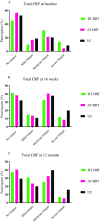High-intensity exercise during chemotherapy induces beneficial effects 12 months into breast cancer survivorship
- PMID: 30912010
- PMCID: PMC6482129
- DOI: 10.1007/s11764-019-00747-z
High-intensity exercise during chemotherapy induces beneficial effects 12 months into breast cancer survivorship
Abstract
Purpose: Whether the benefits of exercise during chemotherapy continue into survivorship is not well-known. Here, the aim was to examine the effects of two exercise interventions on self-reported health-related and objectively measured physiological outcomes 12 months following commencement of chemotherapy.
Methods: Two hundred and forty women with breast cancer stage I-IIIa were randomized to 16 weeks of high-intensity aerobic interval training combined with either resistance training (RT-HIIT), or moderate-intensity aerobic training (AT-HIIT), or to usual care (UC).
Primary outcome: cancer-related fatigue (CRF); secondary outcomes: quality of life (QoL), symptom burden, muscle strength, cardiorespiratory-fitness, body mass, and return to work.
Results: Compared to UC, both RT-HIIT and AT-HIIT significantly counteracted increases in total CRF (ES = - 0.34; ES = - 0.10), daily life CRF (ES=-0.76; ES=-0.50, and affective CRF (ES=-0.60; ES=-0.39). Both RT-HIIT and AT-HIIT reported significantly lower total symptoms (ES = - 0.46, ES = - 0.46), and displayed gains in lower limb (ES = 0.73; ES = 1.03) and handgrip muscle strength (surgery side ES = 0.70, ES = 0.71; non-surgery side ES = 0.57, ES = 0.59). AT-HIIT displayed significant reductions in body mass (ES = - 0.24), improved QoL: role (ES = 0.33) and emotional functioning (ES = 0.40), and a larger proportion had returned to work (p = 0.02) vs UC.
Conclusion: These findings emphasize the beneficial effects of supervised high-intensity exercise during chemotherapy to improve the health and to reduce societal costs associated with prolonged sick leave for patients with breast cancer several months following chemotherapy.
Implications for cancer survivors: These findings provide important information with substantial positive consequences for breast cancer survivorship. High-intensity exercise programs during chemotherapy and support to maintain physical activity can be a powerful strategy to manage or prevent many of the short- and long-term adverse effects of treatment for the increasing cohort of cancer survivors.
Keywords: Breast cancer; Cancer survivorship; Cancer-related fatigue; High-intensity interval training; Randomized controlled trial.
Conflict of interest statement
Conflict of interest
The authors declare that they have no conflict of interest.
Ethical approval
All procedures performed in studies involving human participants were in accordance with the ethical standards of the institutional and/or national research committee and with the 1964 Helsinki declaration and its later amendments or comparable ethical standards. Informed consent was obtained from all individual participants included in the study.
Informed consent
Informed consent was obtained from all individual participants included in the study.
Figures



References
-
- Curt GA, Breitbart W, Cella D, Groopman JE, Horning SJ, Itri LM, Johnson DH, Miaskowski C, Scherr SL, Portenoy RK, Vogelzang NJ. Impact of cancer-related fatigue on the lives of patients: new findings from the fatigue coalition. Oncologist. 2000;5(5):353–360. doi: 10.1634/theoncologist.5-5-353. - DOI - PubMed
Publication types
MeSH terms
LinkOut - more resources
Full Text Sources
Medical

